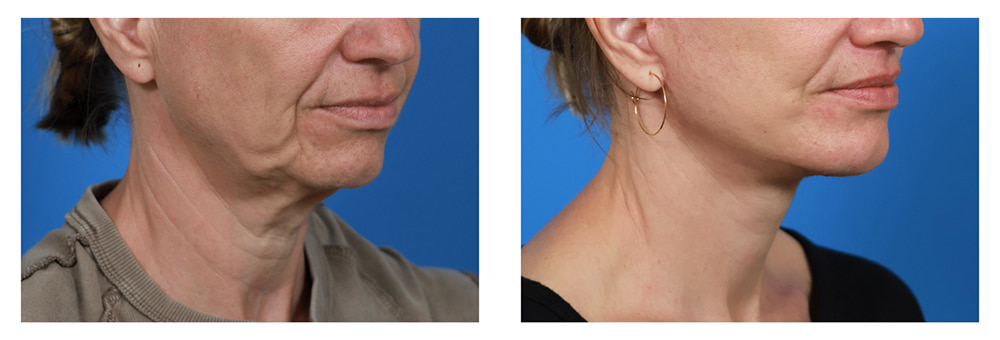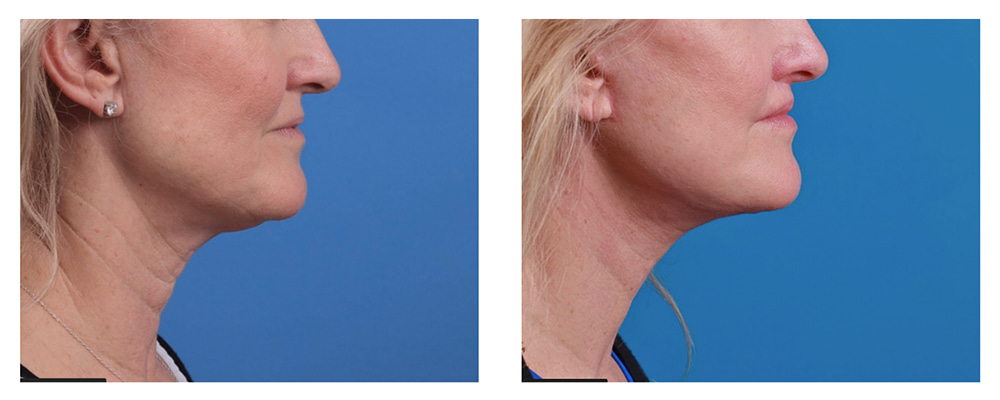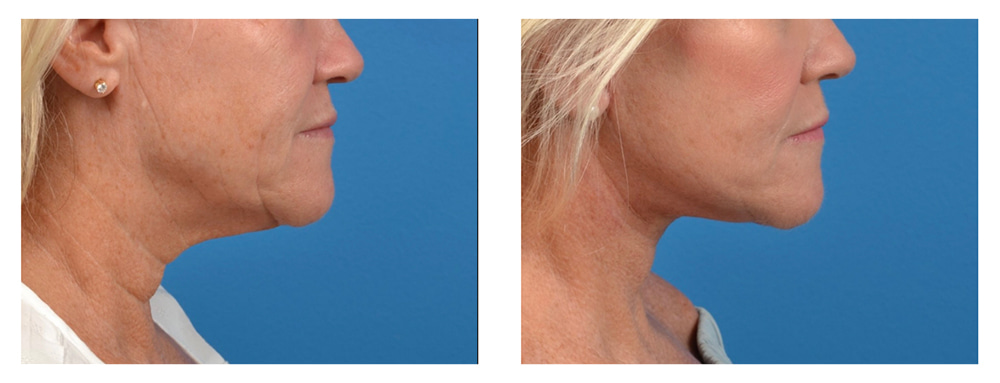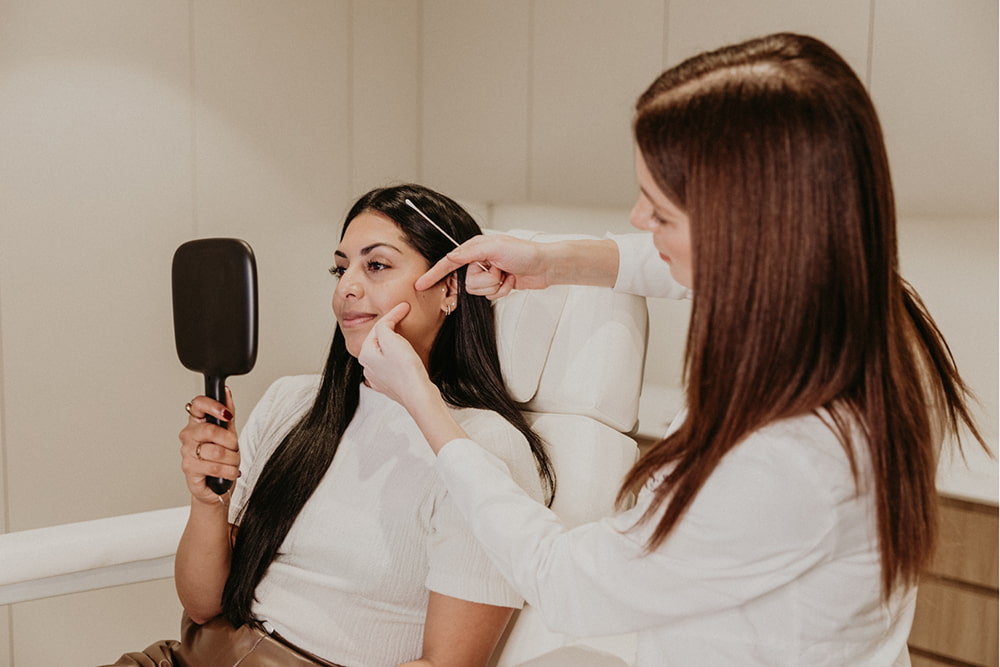



The word “mini” sounds appealing. Lighter lift, quicker recovery, smaller incisions. It also means very different things depending on who is using it. Before I recommend any facelift, I define the terms clearly and match them to a real face in front of me. Surgery labels do not do the work. The surgeon does.
When I say “mini facelift,” I am actually talking about a deep-plane lift that targets the lower face and jowl area. The incisions are placed around the ears, and what makes it “mini” is that I don’t need a separate incision under the chin like I would for a full facelift.
The goal is simple: release and lift the tissues that create early jowls, then redrape the skin without any pulling or tension. That’s the magic of deep-plane techniques: decades of experience have taught us that pulling on the tissues (any layer!) too tight just leads to early relapse of sagging. I often describe it as a precise “tuck” for the jowl and midface, done in the right anatomical layer.
A mini facelift works best for people who have early signs of aging, good skin elasticity, and a relatively youthful neck. If those things aren’t the case, then a full facelift with an under-the-chin incision is usually the better (and necessary) choice.
That brings me to the term “full facelift”. For me, this refers to a comprehensive deep-plane face and neck lift. This addresses jowls, midface descent, neck skin laxity, submental fullness, and platysmal (neck muscle) banding. When the neck needs attention, a small incision under the chin is necessary to allow me to access the midline of the neck, manage deep fat, and restore a sharper neck angle. Same philosophy, broader field of work.

This patient underwent a comprehensive deep-plane face and neck lift, combined with an upper lip lift and chin pre-jowl implant. The left photo shows extensive jowling, loose lower face and neck skin, and visible vertical neck bands. This case demonstrates signs of aging that require a full, comprehensive facelift to achieve the dramatic results seen here, visible just 2.5 months postoperatively on the right.
Other surgeons sometimes use “mini facelift” to mean a very limited skin-only pull or a short-SMAS lift in the office. To be fully transparent, my version of a mini facelift takes anywhere from three to four hours. There’s nothing “mini” about entering the deep plane and carefully tailoring the skin around the ear. Every step requires meticulous attention.
I know many surgeons avoid the term “mini” altogether, pre-signaling that their consultations won’t entertain any scaled-down version of a proper lift. I respect their approach, and I’m on the fence myself about adopting this practice. That said, if procedures differ in any meaningful way, I’m comfortable using different terms to explain them. We can all agree, however, that the word “mini” can be misleading, which is why clear definitions matter from the start. Patients should know exactly what will be done (and what won’t) so expectations are realistic and outcomes are understood.
When I evaluate a face, I start with the skin. Elasticity and how well it “snaps back” often matter more than age. If the skin still has good recoil, a mini facelift may be considered, but it’s just one possibility. I then assess the jawline and the area around the mouth, noting shadows, the depth of lines, and the underlying bone structure, since these factors can influence the final result. I also look at the midface, because if it has descended, it can make the jawline appear more pronounced than it actually is.
Then I assess the most important feature – the neck. I look at the contour from the profile. I check for bands at rest, submental fullness, and the angle between the chin and neck. If the neck shows signs of aging in photos and to my examination, a mini lift will absolutely underdeliver, because the problem is broader than in the lower face. Chin projection is another small but important part of the picture. A recessed chin can exaggerate jowls and shorten the neck visually. Sometimes a conservative chin implant makes the difference between good and great.
Finally, I consider the full “surgical landscape.” Previous treatments, like fillers, thread lifts, energy-based devices, or biostimulatory injections, along with past skin injuries, weight changes, sun exposure, skin thickness, and even hormone therapy, all play a role. Each of these factors helps shape the surgical plan, the pre-surgery preparation, and the recovery I discuss with patients.
In my practice, a mini facelift is designed for early jowling with a reasonably well-preserved neck area. When I see mild to moderate laxity along the jawline and good neck skin recoil, this procedure can create a clean, crisp result while softening the jowls and marionette folds, without the footprint of a larger surgery. Because the lift is performed in the deep plane, the ligaments connecting the SMAS to the underlying structures are properly released, resulting in a tension-free lift with better longevity than a mini SMAS tuck (which does NOT release ligaments and takes less than an hour to perform).
That said, a mini facelift isn’t always the right solution. If the neck shows obvious bands at rest, has significant fullness or loose skin, or bothers a patient when viewed from the side, it requires a dedicated neck approach. I always remind patients that the face and neck are essentially one continuous piece of fabric: enough descent in the face will eventually show in the neck. Trying to solve a neck concern with a lower-face lift alone won’t provide lasting results and often isn’t worth it.

My actual patient. She is undeniably beautiful on both sides of this photo. Her goal was a subtle reduction in nasal size: nothing dramatic, just refined. She breathed well before and continues to breathe beautifully after surgery. This is a perfect example of how small, thoughtful changes can make a big difference. Even so, her transformation required multiple structural grafts to create a nose that is strong, not weak; supported, not pinched; stable, not temporary. I felt confident this result would stand the test of time. I’ll always remember the joy in that moment when we hugged and celebrated her journey together.
I don’t recommend surgery “before you need it.” There’s no real benefit to operating on a face with minimal descent. I operate when the changes produced by surgery will be as visible as the signs of aging we’re trying to improve. This makes the recovery and investment feel meaningful. Early jowling with some cheek sagging can justify a mini facelift, but doing it “just in case” does not.
Not to repeat the same point over and over again, but I prefer and most often use a deep-plane approach for every “mini” facelift. This isn’t just about entering the deep plane under the SMAS; it’s about releasing the right ligaments between the SMAS and underlying structures so the cheek and jowl move as a single unit. This lifts the SMAS–platysma layer while letting the skin glide passively and naturally above it. Older techniques often pull the SMAS from above without release, relying on tension that fades over time. This can stretch scars, weaken the lift, and limit longevity. By lifting from within the deep plane, tension is minimized, healing is more aesthetic at the incision lines, and the results last longer, whether for a mini or a full facelift.
In my practice, both mini and full facelifts are performed in an operating room under general anesthesia, based on my preferred surgical techniques. The main difference in time is how long it takes to address the neck beneath the chin, and this can add one to two hours in older patients with more advanced aging. Older patients are also more likely to benefit from adjunctive procedures, like eyelid or brow lifts, to achieve a complete, harmonious result, which make surgeries involving full facelift typically longer.
Regardless of the procedure length, the setting, sterility, patient comfort, and safety standards remain the same. Every patient receives the same high level of care, whether it’s a mini or comprehensive facelift.
The question I hear most often is, “How long will it last?” Of course, surgical technique matters. We know through extensive pooled data and continuing education that extended deep-plane facelifts produce results that generally last longer than older methods. But even the same technique can look very different depending on which surgeon’s operating room you enter.
Ultimately, biology and behavior determine longevity. No surgery stops aging or gravity. A mini facelift for early jowling can hold nicely for 7–10 years if the skin quality is good, the patient is diligent about avoiding obvious accelerants of aging, and weight remains large stable. Because it’s done earlier, it’s plausible that another procedure may be desired later in life, around age 60, when some patients are only having their first facelift. This is not a failure of prior surgery, this is an expected and normal result of anti-aging surgery. Today, many patients are opting for smaller procedures like mini facelifts at younger ages (late 30s to late 40s) simply because they are eligible for it, not by choice.

A well-performed face and neck lift, like in this patient, shown 1.5 years after I performed a comprehensive deep-plane facelift, continues to hold beautifully over time. Aging is highly individual, influenced by both internal and external factors. Very subtle neck changes may appear around 3–5 years, moderate changes by 5–6 years, and more significant changes by 6–10 years. The decision for a secondary facelift ultimately depends on one’s personal tolerance for visible aging.
A first-time, comprehensive facelift performed with excellent technique typically maintains visible improvement for about 5–10 years. What determines whether it’s closer to 5 or 10? Past and present lifestyle, smoking history, UV exposure, facial movement, Botox use, menopause status, hormone therapy, diet, skin thickness, and nutrition: all of these factors play a role. No two patients age alike, and there’s no exact equation to predict the future. Facelift longevity is as individual as the patient receiving it.

My work begins long before the operating room. The consultation is the cornerstone of every successful result; it’s where trust, understanding, and preparation take shape. Patients who value this process and approach surgery with patience and commitment are the best candidates for something as transformative as a facelift. I hold this standard with pride, even if it means saying no when that alignment isn’t fully there.
Real medical advice can only come from a consultation between a patient and a New York facial cosmetic surgeon. A blog is not the place for individualized guidance, but I am able to highlight general trends I’ve learned to be true.
Start with a consultation, where you review candid photos together with your surgeon. In my consults, I ask what draws your attention first and what you wish looked different. I may gently lift the skin in the mirror to see whether the improvement you want would also involve the neck. We discuss your lifestyle, medications, exposure to pro-aging factors, expectations, mindset for surgery, and downtime readiness. We find the vulnerabilities, the assets, and the in-between. Sometimes, I may tell a patient they aren’t yet a good candidate. But, many times I explain my surgical recommendations in terms of your unique anatomy and how your face has aged thus far.
When anatomy drives the plan, “mini” and “full” aren’t just labels, but rather they become tools, chosen because they are right for the job. My goal is to identify your concerns, apply my experience and vision, and select the approach that will make a real, lasting difference for the face you live in every day.
As always, thanks for reading. This was a long one.
xo, Dr. Renata
Life can be demanding, and we understand. For patients who may be traveling, preparing for a last-minute occasion, or simply looking for a more exclusive experience without any inconvenience or delays, we are pleased to offer preferred patient scheduling. Patients may undergo a personal consultation as well as tailored cosmetic treatments during evening hours or weekends. Appointments are required and premium rates apply. Please call our office to inquire about preferred patient scheduling and allow us to create an exceptional experience just for you.
Request a ConsultationAt RENATA Facial Cosmetic Surgery, patients receive excellent customer service, communication, personal attention, and scheduling flexibility. Located in the historical and breathtaking waterfront neighborhood of DUMBO, Brooklyn in New York City, our office serves local neighborhoods including Brooklyn Heights, Park Slope, Williamsburg, and Cobble Hill, as well as Manhattan and New York City at large.
Our office location is:
58 Prospect Street, Brooklyn, NY 11201